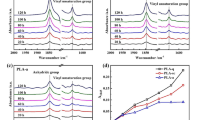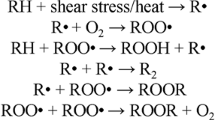Abstract
Renewable resources-based polymers have been the focus of materials science researchers since their use contributes to reducing carbon consumption and the environmental impacts in addition to decreasing the consumption of petroleum derivatives. Among renewable polymers, poly (lactic acid) (PLA) has emerged due to its biodegradable character and proper performance similar to the engineering resins. In this work, we investigated the effect of Aloe Vera (AV) as a photoprotective agent for PLA, since AV has polysaccharides and anthraquinones, such as acemannan and aloin, respectively, able to absorb and dissipate the innocuous energy generated by UV radiation. PLA/AV biocomposites were photodegraded in an aging chamber for 7, 14, 28, 56, and 112 days. Biocomposites with 10% AV displayed higher stability to photodegradation and a 96% reduction in the content of photodegraded material as evidenced by FTIR measurements, even in lower contents i.e., 1% AV decreased 50% of PLA photodegradation. It is suggested that hydrogen bonds between PLA ester group carbonyls and AV compounds’ hydroxyls contribute to the protective effect of AV. Photodegraded PLA/AV presented reasonable thermal stability, which is supposed to be influenced by PLA crosslinking. Acquired results point to AV as a proper candidate as a photoprotective agent for PLA, being environmentally friendly, as they are products from a renewable sources.











Similar content being viewed by others
Data Availability
Data will be made available on request.
References
Latos-Brozio M, Politechniki AM-W (2019) The prospect for the use of biodegradable polymers as a modern and proecological packaging materials. Wydaw Politech Łódzkiej. https://doi.org/10.34658/9788372839206
Moshood TD, Nawanir G, Mahmud F et al (2021) Expanding policy for biodegradable plastic products and market dynamics of bio-based plastics: challenges and opportunities. Sustain 13:6170. https://doi.org/10.3390/su13116170
Mülhaupt R (2013) Green polymer chemistry and bio-based plastics: dreams and reality. Macromol Chem Phys 214:159–174. https://doi.org/10.1002/macp.201200439
Castro-Aguirre E, Iñiguez-Franco F, Samsudin H et al (2016) Poly(lactic acid)—Mass production, processing, industrial applications, and end of life. Adv Drug Deliv Rev 107:333–366. https://doi.org/10.1016/j.addr.2016.03.010
Pillai O, Panchagnula R (2001) Polymers in drug delivery. Curr Opin Chem Biol 5:447–451. https://doi.org/10.1016/S1367-5931(00)00227-1
Henton DE, Gruber P, Lunt J, Randall J (2005) Polylactic acid technology natural fibers, biopolymers and biocomposites. CRC Press 16:527–577
Liechty WB, Kryscio DR, Slaughter BV, Peppas NA (2010) Polymers for drug delivery systems. Annu Rev Chem Biomol Eng 1:149–173. https://doi.org/10.1146/annurev-chembioeng-073009-100847
Donate R, Alemán-Domínguez ME, Monzón M et al (2020) Evaluation of aloe vera coated polylactic acid scaffolds for bone tissue engineering. Appl Sci 10:2576. https://doi.org/10.3390/app10072576
Rabek JF (1995) Polymer photodegradation mechanisms and experimental methods. Springer, Stockholm
Sakai W, Tsutsumi N (2022) Photodegradation and radiation degradation. Wiley, Hoboken
Chen CQ, Ke DM, Zheng TT et al (2016) An ultraviolet-induced reactive extrusion to control chain scission and long-chain branching reactions of polylactide. Ind Eng Chem Res 55:597–605. https://doi.org/10.1021/acs.iecr.5b04094
Musioł M, Sikorska W, Adamus G et al (2016) Forensic engineering of advanced polymeric materials. Part III—biodegradation of thermoformed rigid PLA packaging under industrial composting conditions. Waste Manag 52:69–76. https://doi.org/10.1016/j.wasman.2016.04.016
Shi J, Zhang L, **ao P et al (2018) Biodegradable PLA nonwoven fabric with controllable wettability for efficient water purification and photocatalysis degradation. ACS Sustain Chem Eng 6:2445–2452. https://doi.org/10.1021/acssuschemeng.7b03897
Chamas A, Moon H, Zheng J et al (2020) Degradation rates of plastics in the environment. ACS Sustain Chem Eng 8:3494–3511. https://doi.org/10.1021/acssuschemeng.9b06635
Niesiobędzka J, Głowińska E, Datta J (2021) Eco-friendly ether and ester-urethane prepolymer: structure, processing and properties. Int J Mol Sci 22:12207. https://doi.org/10.3390/IJMS222212207/S1
Xu H, Jiang L, Ke L et al (2022) Unexpected toughening of poly(lactic acid) by microwave-assisted devulcanization of waste latex rubber. ACS Appl Polym Mater. https://doi.org/10.1021/ACSAPM.2C01502/ASSET
Shang H, Ke L, Xu W et al (2022) Microwave-assisted direct growth of carbon nanotubes at graphene oxide nanosheets to promote the stereocomplexation and performances of polylactides. Ind Eng Chem Res 61:1111–1121. https://doi.org/10.1021/acs.iecr.1c04118
Ke L, Shang H, Tang M et al (2022) High-heat and UV-barrier poly(lactic acid) by microwave-assisted functionalization of waste natural fibers. Int J Biol Macromol 220:827–836. https://doi.org/10.1016/j.ijbiomac.2022.08.114
Lv S, Zhang Y, Tan H (2019) Thermal and thermo-oxidative degradation kinetics and characteristics of poly (lactic acid) and its composites. Waste Manag 87:335–344. https://doi.org/10.1016/J.WASMAN.2019.02.027
Chaitanya S, Singh I (2016) Novel aloe vera fiber reinforced biodegradable composites: development and characterization. J Reinf Plast Compos 35:1411–1423. https://doi.org/10.1177/0731684416652739
Chaitanya S, Singh I (2018) Ecofriendly treatment of aloe vera fibers for PLA based green composites. Int J Precis Eng Manuf Green Technol 5:143–150. https://doi.org/10.1007/s40684-018-0015-8
Komatsu D, Mistura DV, Motta A et al (2017) Development of a membrane of poly (L-co-D,L lactic acid-co-trimethylene carbonate) with aloe vera: an alternative biomaterial designed to improve skin healing. J Biomater Appl 32:311–320. https://doi.org/10.1177/0885328217719854
Shen Y, Huang Y, Jiang L, Dan Y (2020) Polylactide with improved optical property by introducing natural functional substance: aloe-emodin. React Funct Polym 148:104486. https://doi.org/10.1016/j.reactfunctpolym.2020.104486
Gupta P, Vermani K, Garg S (2002) Hydrogels: from controlled release to pH-responsive drug delivery. Drug Discov Today 7:569–579
Rodríguez ER, Martín JD, Romero CD (2010) Aloe vera as a functional ingredient in foods. Crit Rev Food Sci Nutr 50:305–326. https://doi.org/10.1080/10408390802544454
O’Brien C, Van Wyk BE, Van Heerden FR (2011) Physical and chemical characteristics of Aloe ferox leaf gel. South Afr J Bot 77:988–995. https://doi.org/10.1016/j.sajb.2011.08.004
Zapata PJ, Navarro D, Guillén F et al (2013) Characterisation of gels from different Aloe spp. as antifungal treatment: potential crops for industrial applications. Ind Crops Prod 42:223–230. https://doi.org/10.1016/j.indcrop.2012.06.002
Freitas VS, Rodrigues RAF, Gaspi FOG (2014) Propriedades farmacológicas da aloe vera (L.) Burm. F. Rev Bras Plantas Med 16:299–307. https://doi.org/10.1590/S1516-05722014000200020
Rodrigues D, Viotto AC, Checchia R et al (2016) Mechanism of Aloe Vera extract protection against UVA: shelter of lysosomal membrane avoids photodamage. Photochem Photobiol Sci 15:334–350. https://doi.org/10.1039/c5pp00409h
Metcalfe C (2019) Quantitation of Aloe vera polysaccharides by O-acetyl and UV–Vis spectrophotometry: first action 2018.14. J AOAC Int 102:1091–1094. https://doi.org/10.5740/jaoacint.18-0400
Wang M, Shen Y, Jiang L et al (2021) Polylactide materials with ultraviolet filtering function by introducing natural compound. Polym Technol Mater 60:1098–1105. https://doi.org/10.1080/25740881.2021.1876883
G-154 A (2006) ASTM G-154 operating fluorescent light apparatus for UV exposure of nonmetallic materials. Annual Book of ASTM Standards, Pennsylvania, pp 646–654
Kumar MS, Datta PK, Dutta Gupta S (2009) In vitro evaluation of UV opacity potential of Aloe vera L. gel from different germplasms. J Nat Med 63:195–199. https://doi.org/10.1007/s11418-008-0299-z
Godinho JF, Berti FV, Müller D et al (2016) Incorporation of aloe vera extracts into nanocellulose during biosynthesis. Cellulose 23:545–555. https://doi.org/10.1007/s10570-015-0844-3
Silva IDS, Barros JJP, Albuquerque A et al (2020) Insights into the curing kinetics of EPOXY/PLA: implications of the networking structure. Express Polym Lett 14:1180–1196. https://doi.org/10.3144/expresspolymlett.2020.96
Nourish RGW, Bamford CH (1936) Photodecomposition of aldehydes and ketones [11]. Nature 138:1016. https://doi.org/10.1038/1381016a0
Copinet A, Bertrand C, Govindin S et al (2004) Effects of ultraviolet light (315 nm), temperature and relative humidity on the degradation of polylactic acid plastic films. Chemosphere 55:763–773. https://doi.org/10.1016/j.chemosphere.2003.11.038
Belbachir S, Zaïri F, Ayoub G et al (2010) Modelling of photodegradation effect on elastic-viscoplastic behaviour of amorphous polylactic acid films. J Mech Phys Solids 58:241–255. https://doi.org/10.1016/j.jmps.2009.10.003
Bocchini S, Fukushima K, Di Blasio A et al (2010) Polylactic acid and polylactic acid-based nanocomposite photooxidation. Biomacromolecules 11:2919–2926. https://doi.org/10.1021/bm1006773
Sefl O, Vesely P, Minar J, Dusek K (2020) Novel Electrical Insulation Materials - Photodegradation Endurance of 3D Printed Polylactic Acid. In: Proceedings of the 2020 International Conference on Diagnostics in Electrical Engineering, Diagnostika 2020. Institute of Electrical and Electronics Engineers Inc, Pilson, pp 1–5
Andrady AL, Pandey KK, Heikkilä AM (2019) Interactive effects of solar UV radiation and climate change on material damage. Photochem Photobiol Sci 18:804–825. https://doi.org/10.1039/C8PP90065E
Melo TCS, Calixto GQ, Melo DMA, Aguiar EM, Braga R (2021) Valorização dos resíduos do processamento do urucum através da pirólise flash, chap 6. In: Processos Químicos e Biotecnológicos. Poisson Publisher, Minas Gerais, Brazil. https://doi.org/10.36229/978-65-5866-059-0.CAP.06
Aghamohamadi N, Sanjani NS, Majidi RF, Nasrollahi SA (2019) Preparation and characterization of Aloe vera acetate and electrospinning fibers as promising antibacterial properties materials. Mater Sci Eng C 94:445–452. https://doi.org/10.1016/j.msec.2018.09.058
Palmay P, Mora M, Barzallo D, Bruno JC (2021) Determination of thermodynamic parameters of polylactic acid by thermogravimetry under pyrolysis conditions. Appl Sci 11:10192. https://doi.org/10.3390/app112110192
Tarani E, Pušnik Črešnar K, Zemljič LF et al (2021) Cold crystallization kinetics and thermal degradation of pla composites with metal oxide nanofillers. Appl Sci 11:3004. https://doi.org/10.3390/app11073004
de Rezende CA, Duek EAR (2003) Blendas de poli (ácido lático-co-ácido glicólico)/ poli (ácido lático): degradação in vitro. Polímeros 13:36–44. https://doi.org/10.1590/s0104-14282003000100009
Campaña O, Guerrero, Hugo V (2018) Caracterización Mecánica y Térmica de Ácido Poliláctico (PLA) reforzado con polvo de Bambú (PB). Rev Politécnica 42:8
Koo GH, Jang J (2013) Preparation of melting-free poly(lactic acid) by amorphous and crystal crosslinking under UV irradiation. J Appl Polym Sci 127:4515–4523. https://doi.org/10.1002/app.38056
Hachana N, Wongwanchai T, Chaochanchaikul K, Harnnarongchai W (2017) Influence of crosslinking agent and chain extender on properties of gamma-irradiated PLA. J Polym Environ 25:323–333. https://doi.org/10.1007/s10924-016-0812-5
**a X, Shi X, Liu W et al (2020) Effects of gamma irradiation on properties of PLA/flax composites. Iran Polym J 29:581–590. https://doi.org/10.1007/s13726-020-00820-w. (English Ed)
Zuo Y, Chen K, Li P et al (2020) Effect of nano-SiO2 on the compatibility interface and properties of polylactic acid-grafted-bamboo fiber/polylactic acid composite. Int J Biol Macromol 157:177–186. https://doi.org/10.1016/j.ijbiomac.2020.04.205
Feng Z, Adolfsson KH, Xu Y et al (2021) Carbon dot/polymer nanocomposites: from green synthesis to energy, environmental and biomedical applications. Sustain Mater Technol 29:e00304
Funding
The authors would like to acknowledge the financial support from the Coordenação de Aperfeiçoamento de Pessoal de Nível Superior (CAPES), from Conselho Nacional de Desenvolvimento Científico e Tecnológico (CNPq) and Fundação de Apoio à Pesquisa do Estado da Paraíba (FAPESQ) (Concession term: 017/2019). Professor Renate Wellen is CNPq fellow (Grant No. 303426/2021-7).
Author information
Authors and Affiliations
Contributions
All authors reviewed the manuscript.
Corresponding author
Ethics declarations
Conflict of interest
There is no conflict of interest and all authors have agreed with this submission and they are aware of the content.
Additional information
Publisher's Note
Springer Nature remains neutral with regard to jurisdictional claims in published maps and institutional affiliations.
Supplementary Information
Below is the link to the electronic supplementary material.
Rights and permissions
Springer Nature or its licensor (e.g. a society or other partner) holds exclusive rights to this article under a publishing agreement with the author(s) or other rightsholder(s); author self-archiving of the accepted manuscript version of this article is solely governed by the terms of such publishing agreement and applicable law.
About this article
Cite this article
Nicácio, P.H.M., Albuquerque, A.K.C., Ries, A. et al. Photodegradation Investigation Points to Aloe Vera as a Photoprotector for Poly(Lactic Acid). J Polym Environ 31, 3538–3550 (2023). https://doi.org/10.1007/s10924-023-02811-3
Accepted:
Published:
Issue Date:
DOI: https://doi.org/10.1007/s10924-023-02811-3




